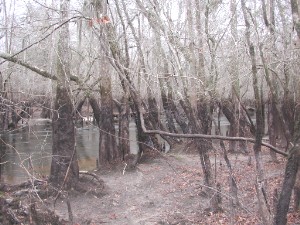Flood plain
|
|
Johnsonville, South Carolina
Showing high water mark on tupelo and cypress trees
In geography, a flood plain is a plain formed of sediment, typically dropped by a river.
When the slope down which a river runs has become very slight, it is unable to carry the sediment brought from higher regions nearer its source, and consequently the lower portion of the river valley becomes filled with alluvial deposits. Since, in times of flood, the rush of water in the high regions tears off and carries down a greater quantity of sediment than usual, the river spreads this sediment over the lower plain. Here, the rush of water is checked, and the stream drops its extra sediment load.
Flood plains are sometimes very large. That of the Mississippi below Ohio has a width of from 20 to 80 miles (30 to 130 km), and its whole extent has been estimated at 50,000 square miles (130,000 km²). Flood plains may be the result of planation, with aggradation. That is, they may be due to a graded river working in meanders from side to side, widening its valley by this process and covering the widened valley with sediment. Or the stream -- by cutting into another stream (piracy), by cutting through a barrier near its head waters, by entering a region of looser or softer rock, and by glacial drainage -- may form a flood plain simply by filling up its valley (alluviation only).
Any obstruction across a river's course, such as a band of hard rock, may form a flood plain behind it, and indeed anything that checks a river's course and causes it to drop its load will tend to form a flood plain. Still, flood plains are most commonly found near the mouth of a large river, such as the Rhine, the Nile, or the Mississippi, where there are occasional floods and the river usually carries a large amount of sediment. "Levees" are formed, inside which the river usually flows, gradually raising its bed above the surrounding plain. Occasional breaches during floods cause the overloaded stream to spread in a great lake over the surrounding country, where the silt covers the ground in consequence.
Sections of the Missouri flood plain taken by the United States geological survey show a great variety of material of varying coarseness, the stream bed being scoured at one place, and filled at another by currents and floods of varying swiftness, so that sometimes the deposits are of coarse gravel, sometimes of fine sand or of fine silt, and it is probable that any section of such an alluvial plain would show deposits of a similar character.
The flood plain during its formation is marked by meandering or anastomosing streams, ox-bow lakes and bayous, marshes or stagnant pools, and is occasionally completely covered with water. When the drainage system has ceased to act or is entirely diverted for any reason, the flood plain may become a level area of great fertility, similar in appearance to the floor of an old lake. The flood plain differs, however, inasmuch as it is not altogether flat. It has a gentle slope down-stream, and often, for a distance from the side towards the center.et:Lamm

